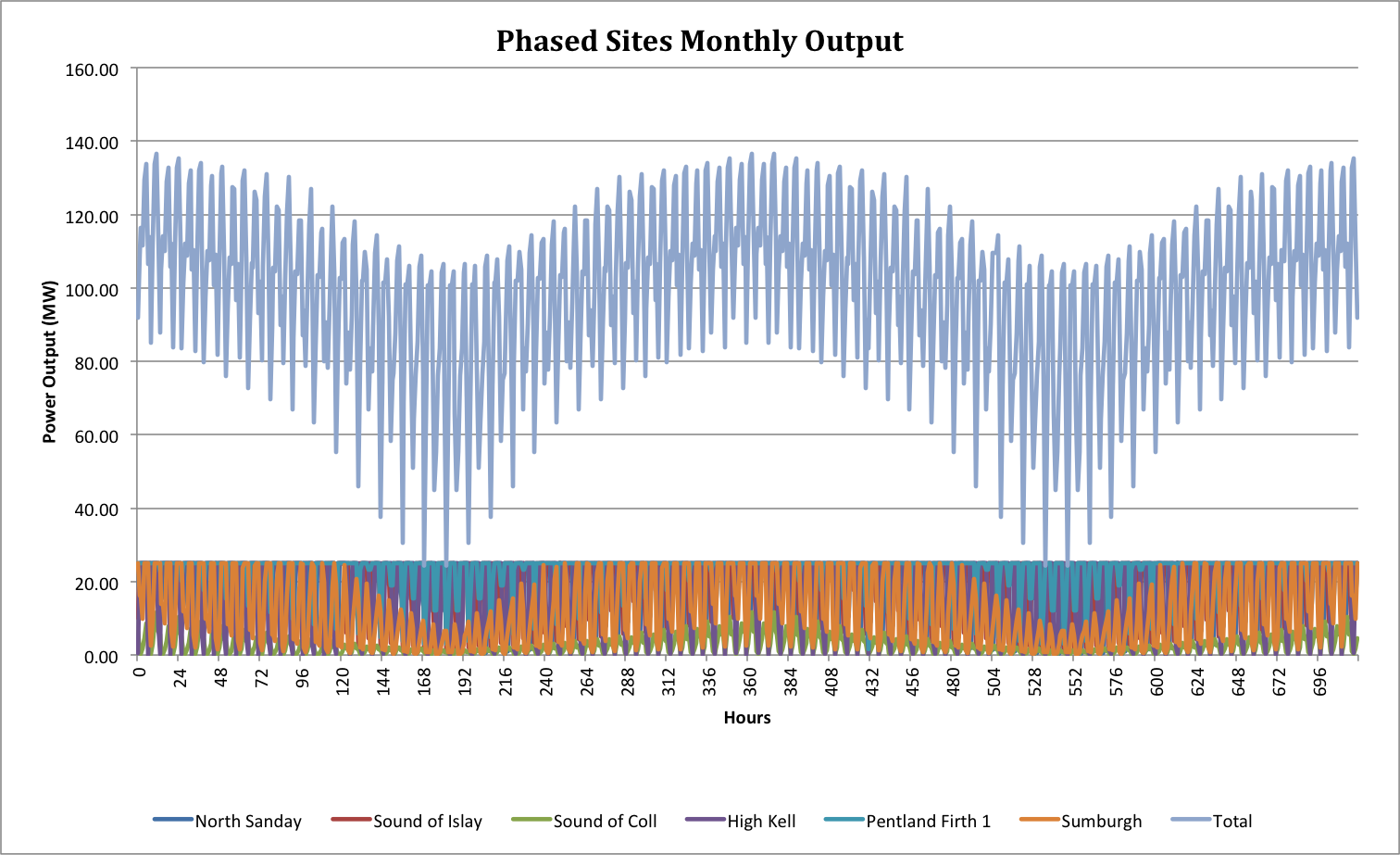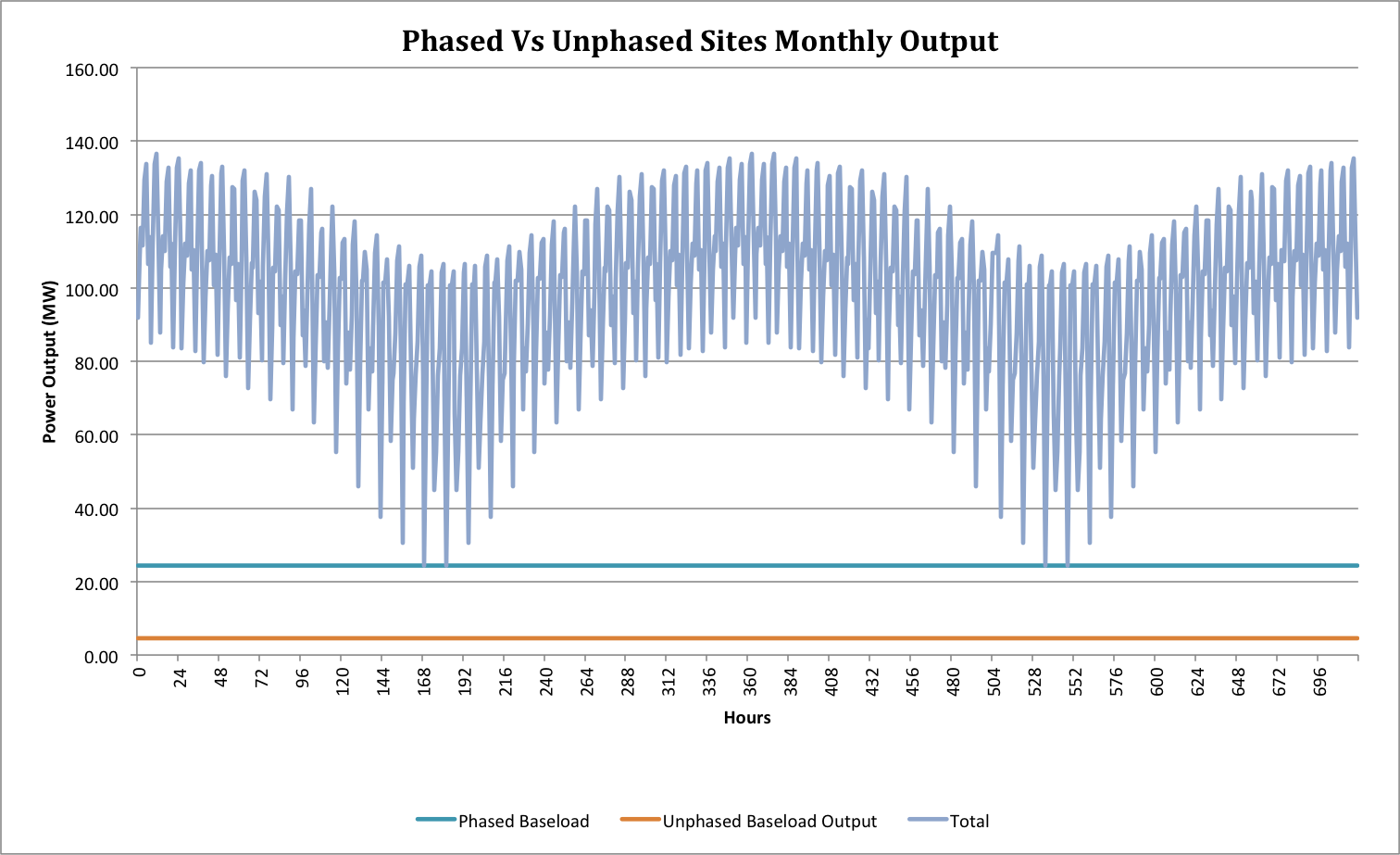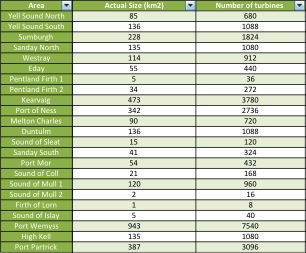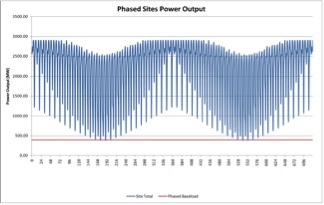- Introduction
- Tidal Energy
- Resource
- Constraints
- Phasing
- Economic Analysis
- Conclusions
- Downloads
Tidal Phasing Results
Phasing Results-Site Selection
By using the tidal phasing tool it was possible to determine the best combination of sites from those investigated. For analytical purposes we considered the case where 100 turbines were deployed at each site-each of these turbines had a rated power output of 250kW, a performance coefficient (Cp) of 0.45 and a rotor diameter of 20m. Different combinations of sites were tried and the combination that produced the highest baseload power output was judged to be the best combination of sites. As you can see the distribution of these sides across Scotland would indicate that they have good phasing potential.


The graph below shows the monthly power output for the six sites analysed in this study. This again considers the situation where 100 turbines are deployed at each site with each of these turbines having a rated power of 250kW, a performance coefficient of 0.45 and a rotor diameter of 20m. This arrangement gives a guaranteed baseload power output of 47.38MW for an installed capacity of 150MW. This equates to a monthly energy output of about 88,800 MWh giving a capacity factor for this arrangement of 76%.

This graph displays the difference between the baseload power output for the chosen sites in phase and the baseload power output of the sites if they were to be considered individually. This reinforces the importance of phasing and shows how it can be of use in terms of security of supply

Although this specific site arrangement does not have the baseload capacity to displace Scotland’s smallest conventional fossil fuelled power station (800MW) it would have the baseload provision to supply a significant level of power to industrial users such as whisky distilleries or manufacturing plants.
Phasing Results-Site Optimistion
In order to analyse the realistic potential for tidal phasing it was necessary to determine the number of turbines that could be deployed in a given area. By using the results of our analysis into the effect of technical and policy constraints in specific areas and assuming a relevant packing density of 8 devices per 1km2 it was possible to approximate the number of turbines that could be deployed in a given site area.
This is an appropriate approximation for this study however more detailed flow modelling would need to be undertaken in order to establish the packing density at a specific site.
The table below shows the areas analysed, the unconstrained site area and the number of turbines that could be deployed in the given areas.

In order to investigate how this affects the baseload power output the maximum amount of deployable turbines within an area was changed in the tidal phasing tool. Again the best combination of sites was chosen for analysis. In this case the number of turbines at each site was changed and the turbines were given a rated power of 250kW, a performance coefficient (Cp) of 0.45 and a turbine diameter of 20. The analysis showed that it possible to deploy a total installed capacity of 2.9GW across the six tidal areas. This could guarantee a baseload power output of 396MW and would produce and energy output of 160TWh a month operating at a capacity coefficient of 77%.

This case shows that through the phasing of carefully selected tidal sites it is possible to produce a baseload power output of around 400MW, which is approximately 3% of Scotland’s electricity demand. Although this baseload power output is not quite enough to displace any of Scotland’s smaller conventional power plants (800MW-1200MW) it could still supply a significant power output on its own. It may be the case that in the future the tidal industry is forced to investigate ways of overcoming the technical and policy constraints and this could lead to the situation where more turbines can be deployed at some of these sites. This could lead to a future scenario where the phasing of tidal sites could potentially displace conventional means of generation in Scotland.
References:
[1] Clarke J.A. Connor G. Grant A.D. Johnstone C.M. The impact of limiting tidal turbine capacity on the output characteristics from three complimentary tidal sites in Scotland over the lunar cycle. ESRU- University of Strathclyde.